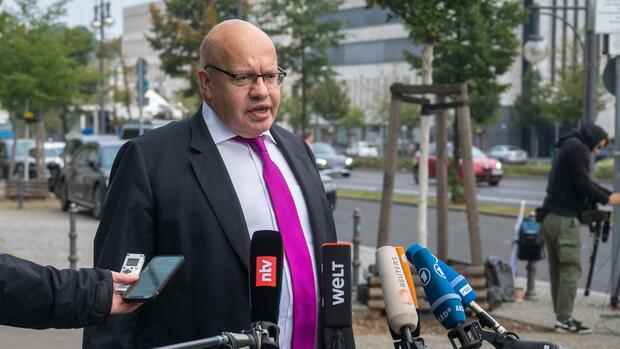The outgoing Federal Minister of Economics is lowering what will probably be his last growth forecast.
(Photo: dpa)
Berlin The outgoing Federal Minister of Economics, Peter Altmaier, has to revise his last growth forecast for the German economy significantly downwards. This year it should only be enough for an increase of 2.6 percent instead of the 3.5 percent promised in the spring. The CDU politician confirmed a Handelsblatt report from Tuesday in Berlin on Wednesday.
The German economy will reach and exceed its pre-Corona level again at the end of the first quarter of 2022. “A quarter later than originally assumed,” said Altmaier. “The prerequisite is, of course, that the growth path is not stalled in the next few months.”
Next year, the economy is projected to grow by 4.1 percent, 0.5 points more than previously thought. 1.6 percent is expected for 2023.
“In view of the current delivery bottlenecks and high energy prices around the world, the hoped-for final spurt will not come this year,” said Altmaier. In 2022, however, the economy will pick up speed significantly. That would be good news for the new federal government, which the SPD, Greens and FDP are currently negotiating. It is urgently dependent on increasing tax revenues in order to make additional investments for climate protection and digitization.
Top jobs of the day
Find the best jobs now and
be notified by email.
According to Altmaier, the sharp rise in the number of corona infections can dampen the upswing – even without a new lockdown. “We have a second pandemic winter ahead of us,” says the CDU politician. He assumes that new lockdowns can be dispensed with. The high number of infections could, however, “lead to negative economic effects”. It is therefore important to continue to wear masks and to observe precautionary rules.
The economic situation is currently divided into two parts, according to Altmaier. The service providers benefited from the vaccination progress. Private consumption is one of the drivers of the recovery from the corona crisis. In contrast, the industry is feeling the shortage of preliminary products. That slows down the industry in the second half of 2021. As soon as the supply bottlenecks disappear, there should be catch-up effects in 2022.
Altmaier had last raised the growth forecast for 2021 at the end of April due to a sharp rise in exports and then expressed himself optimistically in the summer that even slightly stronger growth might be possible.
Federal government: inflation eases at the turn of the year
The federal government also expects consumer prices to rise significantly more slowly in the coming year. The inflation rate will be 3.0 percent this year, as high as it has been since 1993, as the autumn projection shows. In 2022, however, it is expected to decrease to 2.2 percent and even to 1.7 percent in 2023. For comparison: In 2020, which was shaped by the corona crisis, the rate of price increase was only 0.5 percent.
“The supply bottlenecks and the recent sharp rise in energy prices have led to an increase in the inflation rate,” said the Ministry of Economic Affairs, referring to the current development. It assumes that the inflation rate will “reach a significantly lower level” again by the turn of the year 2021/22.
The reason for this is that special factors are then omitted. This includes that the prices in the new year are no longer compared with those of the second half of 2020, when many goods and services were cheaper due to the temporarily reduced VAT.
At 4.1 percent, the inflation rate is currently at its highest level since 1993. Many economists assume that it will initially move further towards five percent. For October, for example, a value of 4.4 percent is expected. The Federal Statistical Office published a first estimate this Thursday.
More: Olaf Scholz expects lower national debt this year
